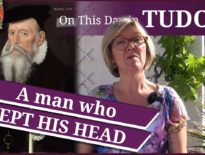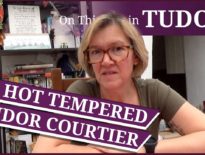On this day in history, 2nd May 1550, Anabaptist Joan Bocher, was burnt to death at Smithfield for her belief in Christ's celestial flesh.
How did a Protestant end up being executed in Edward VI's reign and what did she mean by Christ having celestial flesh?
Find out more about Joan Bocher, or Joan of Kent, her beliefs and her links to Protestant martyr Anne Askew, in today's talk.
Also on this day in Tudor history, 2nd May 1568, Mary, Queen of Scots, who had recently been forced to abdicate in favour of her son, King James VI, successfully escaped from Lochleven Castle.
How did she end up a prisoner at Lochleven? How did she escape? And what happened next? Find out in last year’s video:
And on 2nd May 1536, Queen Anne Boleyn and her brother, Lord Rochford, were arrested and taken to the Tower of London. Find out more in the 2nd May 1536 video:
Here's William Wordsworth's sonnet "Edward signing the warrant for the execution of Joan of Kent":
"THE tears of man in various measure gush
From various sources; gently overflow
From blissful transport some--from clefts of woe
Some with ungovernable impulse rush;
And some, coeval with the earliest blush
Of infant passion, scarcely dare to show
Their pearly lustre--coming but to go;
And some break forth when others' sorrows crush
The sympathising heart. Nor these, nor yet
The noblest drops to admiration known,
To gratitude, to injuries forgiven--
Claim Heaven's regard like waters that have wet
The innocent eyes of youthful Monarchs driven
To pen the mandates, nature doth disown."
Also on this day in history:
- 1542 – Burial of Henry Clifford, 1st Earl of Cumberland and close friend of Henry VIII, at Skipton Church in Yorkshire. Cumberland served the King as Warden of the West Marches, and was rewarded for his service and loyalty during the Pilgrimage of Grace by being elected as a Knight of the Order of the Garter.
- 1551 – Birth of William Camden, historian, headmaster and herald, at the Old Bailey, London. Camden is known for his “Britannia”, the first chorographical survey of Great Britain and Ireland, and his Annales Rerum Gestarum Angliae et Hiberniae Regnate Elizabetha, his history of Elizabeth I's reign, but he also wrote a Greek grammar and “Remaines of a Greater Worke, Concerning Britaine”, which was a collection of historical essays.
- 1587 – Burial of Sir Thomas Bromley, Lord Chancellor, in Westminster Abbey.
- 1620 – Burial of Edward More, poet and grandson of Sir Thomas More. He was buried at Barnborough, Yorkshire.
Transcript:
On this day in history, 2nd May 1550, Anabaptist Joan Bocher or Boucher, was burnt to death at Smithfield.
Let me tell you more about Joan, who was also known as Joan of Kent, Joan Knell, Joan Baron and Joan Barnes, and what led to her being burnt at the stake in the Protestant Edward VI’s reign…
We actually know very little about Joan, but Kirk MacGregor, in his article “The Theology of English Anabaptist Martyr Joan Bocher”, writes that she was probably born Joan Knell and that she came originally from Steeple Bumpstead in Essex, which was known for being a centre of Lollardy, a pre-Protestant Christian religious movement. He believes that she was influenced in her early life by Lollard beliefs. She appears to have been widowed by 1528, when she got into trouble with Bishop Tunstall who was acting against Lollardy in the area. It is said that she escaped further trouble by recanting, even though she didn’t mean it and had no intention of giving up her faith.
In his book “The Radical Brethren: Anabaptism and the English Reformation to 1558”, Irvin B Horst described her “A lady of considerable social standing, possibly of noble blood, she possessed an uncompromising character along with sufficient knowledge of the Bible to dispute intelligently with the theologians of the time”, and 16th century Jesuit Robert Persons wrote of her being active in circulating William Tyndale’s New Testament and described her as being a “great reader of Scripture”. She was active in Reformist circles by the 1530s and in his Ecclesiastical Memorials, John Strype, who cites Persons, writes of how, in dispersing Tyndale’s work at court in Henry VIII’s reign, Joan “became known to certain women of quality, and was more particularly acquainted with Mrs. Anne Ascue”, Anne Askew, of course, being the famous Protestant martyr burnt at the stake in 1546. Strype goes on to describe how Joan would tie the New Testaments in string under her apparel to pass around court.
According to martyrologist John Foxe, Joan also spent time visiting those of the Reformed faith who had been imprisoned, to give them encouragement. In 1541, she was in trouble again for breaking the Easter fast by eating a calf’s head and she had also slandered the Sacrament of the Altar, and she was imprisoned for a time. By 1543, she had remarried and appears to have been based in Kent.
In the mid to late 1540s, Joan came to believe in an idea known as celestial flesh. She believed that Christ's flesh was “not incarnate of the Virgin Mary”, i.e. that Christ did not derive his humanity, his earthly body, from his mother, but that it was celestial or heavenly flesh. Her biographer, Andrew Hope, points out that this belief was unusual in England at the time and that it is likely she picked it up from Dutch Anabaptist refugees who’d come to England early in Edward VI’s reign. She was arrested in 1548 or 1549, and convicted of heresy in April 1549. When she was condemned to death, she said “It is a goodly matter to consider your ignorance. It was not long ago since you burned Anne Ascue for a piece of bread, and yet came yourselves soon after to believe and profess the same doctrine for which you burned her. And now forsooth you will needs burn me for a piece of flesh, and in the end you will come to believe this also, when you have read the Scriptures, and understand them.”
Joan wasn’t executed straight away, but, instead, imprisoned for a year and held for some of that time at the home of Richard Rich, Lord Chancellor, while the Archbishop of Canterbury and Nicholas Ridley, Bishop of London, tried to persuade her to give up her heretical beliefs and become a more conservative Protestant. Joan refused their pleas. On 27th April 1550, Edward VI’s privy council issued their warrant to Lord Chancellor Rich to make out a writ to the Sheriff of London for her execution, but, according to John Foxe, twelve-year-old Edward VI did not want to sign Joan’s death warrant and Archbishop Cranmer had to persuade him by saying that he would take responsibility for it before God.
On 2nd May 1550, Joan was taken to Smithfield for her execution and there, John Scory, the future Bishop of Rochester and Chichester, preached. John Strype recorded that “When she came to die in Smithfield, and Dr. Scory endeavoured to convert her, she scoffed at him, and said, he lied like a rogue; and bade him, Go, read the Scriptures.” She went to her death standing firm in her faith.
Andrew Hope concludes his biographical article of her by saying “It was not for her views however, which despite the fears of the Edwardian establishment never became popular, but as a victim of intolerance that Joan Bocher was to be remembered—and by none more eloquently than William Wordsworth in whose sonnet to her she is described as condemned by 'mandates nature doth disown'”.



Leave a Reply